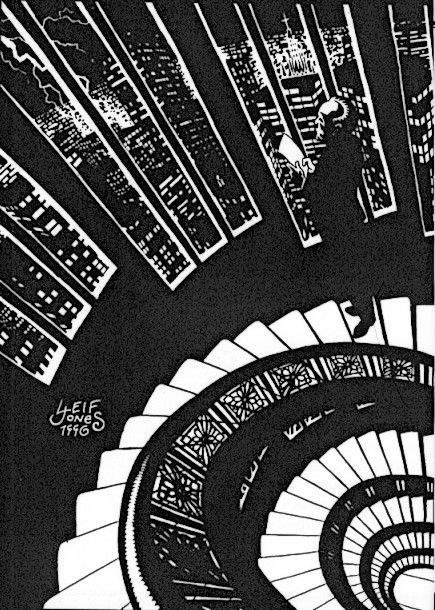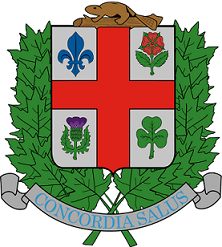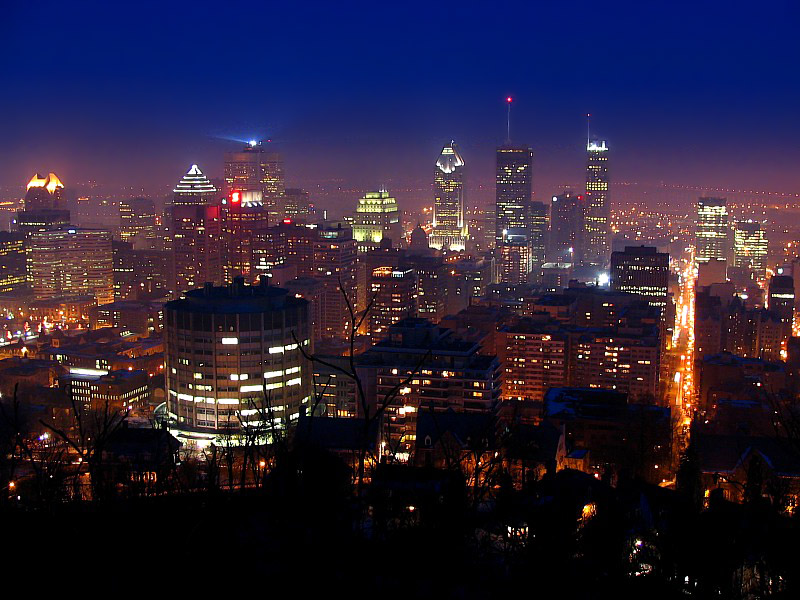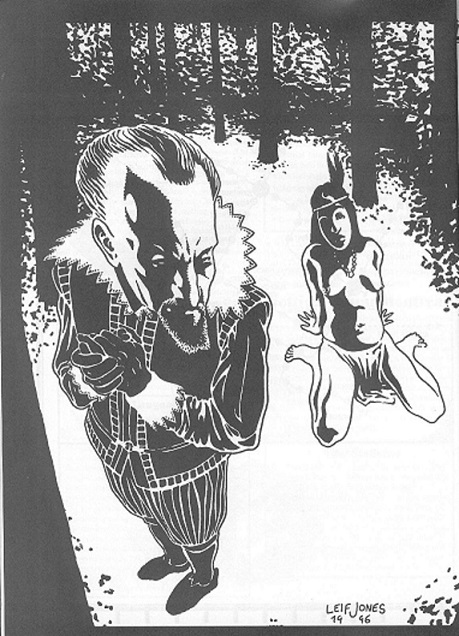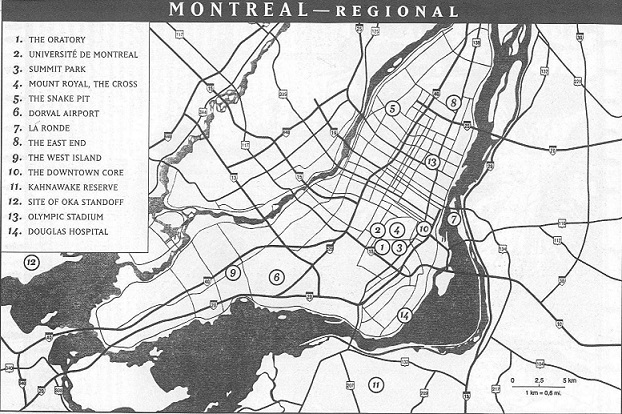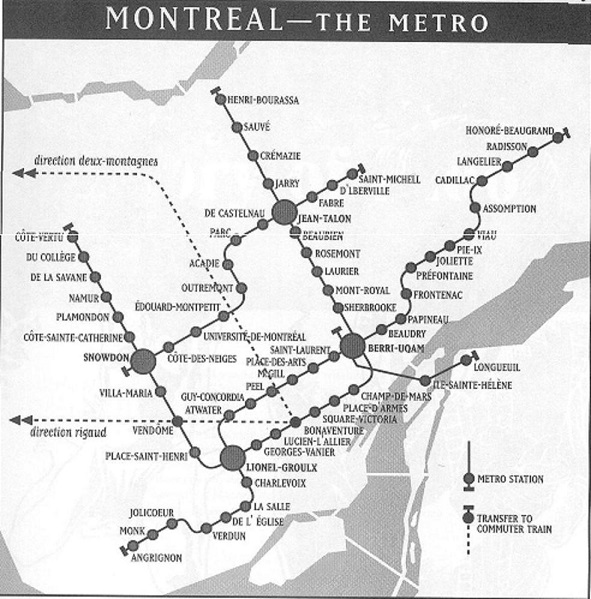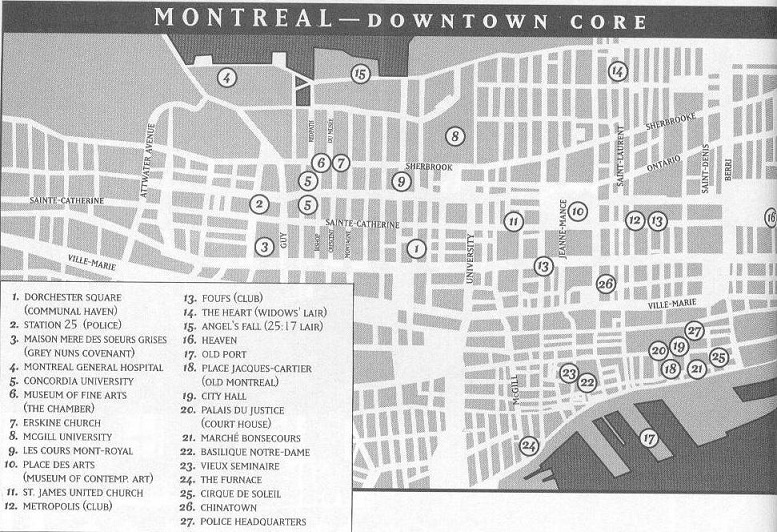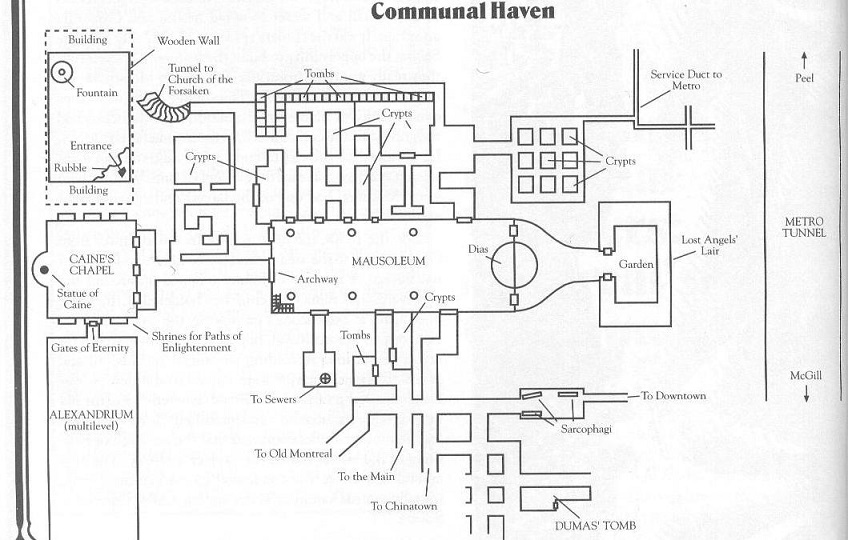Montreal
- North America -- Quebec City -- Toronto -- Camarilla
The Prelude
- I would ask how Fortune smiles upon you These Days, but I know Fate has dealt us a cruel blow. The death of my mentor and your colleague Zhou has left us bereft of a dear friend and valued champion of the Sabbat.
- You once asked me if Montreal was still "The City of Black Miracles" and laughed at my hesitation when I could not answer. I fear now that whatever answer I may have formed since those days has been undermined by deliberate attempts to shroud the Truth. The death of Zhou merely brought certain issues to the fore in the dark time after my induction into the Sabbat. Many were relieved to have weathered the storm; I know now that we merely stood in its eye.
- We in Montreal are about to be cast back into the capricious nightmare. Zhou's death, I suspect, was only an omen of things to come. When I was asked to tend to my mentor's remains and belongings, I approached the matter with trepidation. Zhou could do no wrong in my eyes and I feared, perhaps subconsciously, that assuming such a task would only prove that he did indeed fall to the Ultimate Weakness - death. Yet I steeled myself to what had to be done and discovered an odd comfort in the act of sorting through his belongings. That is when I discovered his codes.
- As you well know, Zhou was fond of artwork, particularly Taoist-influenced pieces. He was quite adept at painting landscapes, applying a balanced approach to the dynamics of nature. He even taught me how to interpret paintings, not as reproductions but as symbolic representations. I now suspect that he was not grooming me to appreciate Chinese artwork, but tutoring me in how to decipher an intricate code should any harm befall him.
- In sorting through Zhou's paintings, I came across a art pad filled with Montreal's landscapes painted in the Taoist manner. I immediately noticed that the pieces were subtly imbalanced. The Yin and Yang of features and animals were stilted. Harmony was askew. At first I wondered if these had been Zhou's early failed attempts to perfect his craft, but the style of his brush-strokes suggested more recent work.
- Whether it was inspiration or luck, something in his pieces urged me to visit the sites Zhou had depicted in his paintings. It was some time before the first mystery revealed itself to me; his paintings, true to his lessons, were not actual representations but the pieces of a Taoist map. Thus, it was through the paintings that I discovered the first of the ledgers that Zhou had hidden in the city.
- Some time ago, my friend made a discovery that he shared only with the pages that he wrote upon. He broke the code to the ramblings of Jacob the Glitch, the Tremere Antitribu who is regularly given to visions and speaking in tongues. My gifted mentor had somehow discovered a way to translate Jacob's Babylonian blather. How that must have frightened him! But despite any apprehension he may have felt, Zhou recorded the Tremere's words in his ledgers and hid them so that no one would know the horrible truths he learned.
- I do not know what to do, Cardinal. I know more books are hidden in the city, but I have been reticent to retrieve them. Some force shadows my every step. I cannot evade it, I cannot confront it, but I know that harm will soon befall me. Upon awakening, I know that my lair has been disturbed while I slumbered. I have taken to resting in the communal haven, but I fear its walls are no protection against an untimely end.
- It has taken me a century to acquire the ledgers that I now possess; should I be destroyed, they may go unseen for all time. I cannot relate the information that I have learned; it is too complex and important to be discussed so casually. We thought the Camarilla to be the greatest threat to our sect; it is not.
- I am in need of immediate protection. I no longer trust those around me. Zhou's murderer walks among them and - I suspect - is the very same person who wishes to visit harm upon me. Please do not hesitate on this matter. I have hidden the paintings and books that I have recovered thus far. The Sabbat cannot afford to be ignorant of this collected gospel.
- You once asked me if Montreal was still "The City of Black Miracles." Now I can only mourn in response. It is blacker than you think.
- -- A letter from an unidentified Cainite to Cardinal Strathcona
Theme & Mood
- Theme
- The central theme of Montreal by Night is faith. Faith is used ironically, not in definition but in application. Faith among Montreal's Sabbat is a matter of conviction more than of belief or religion. It is the driving force behind those who would commit murder because they abhor murder. It is the justification of torture in the name of salvation. It explains the unimaginable and is the defense of those who make martyrs of their victims.
- For the Sabbat, faith is the power to accomplish great things, even beyond the confines of a pack and Vaulderie. The Sabbat severed the ties of mortality and morality and filled the resulting void with their own brand of faith. In Montreal, faith is not an unattainable ideal, but a reality, and its consequences can be both inspirational and destructive.
- Mood
- Montreal is a city of enigmas, an onion of almost infinite layers, if you will. Peel away one skin and several more await, seductive in what they hide. Montreal is called "The City of Black Miracles" because of the dark faith of its nocturnal inhabitants. Those who live within its island confines, whether mortal or immortal, should be made to feel as if some terrible force looms just beyond the senses.
- Montreal is also a city of contrasts, where modern skyscrapers tower over old churches and cathedrals. The New and the Old World clash, not only for mortals, but for the undead. Mention of the Sabbat conjures images of the crime-infested streets of New York, the despair-gripped populace of Detroit, the black heart of Mexico City and the moral debauchery of Amsterdam. These modern interpretations of the Sabbat apply to Montreal, but the Cainites also make Montreal a city of knowledge and faith.
- New York and Mexico City attract the bloodthirsty. Detroit appeals to the downtrodden. Amsterdam lures the abusive. Montreal draws the scholarly and educated among the Sabbat. The problem with the acquisition of knowledge, however, is that it invariably exposes more mysteries - one of the city's moods feeds the other.
- Knowledge is therefore power among the city's "intellectual" Cainites. There isn't one among them who doesn't have a stake in some secret or another.
Coat of Arms
Appearance
Location
Climate
Geography
"I had not thought death had undone so many."
"Sighs, short and infrequent, were exhaled,"
"And each man fixed his eyes before his feet."
--- T.S. Eliot, The Waste Land
- Old stone buildings, secluded squares lost amidst winding streets, and towering church steeples grant real-world Montreal a Gothic ambiance. Montreal' World of Darkness counter-part is not a city of sublime and timeless beauty, but one of subtle and unmistakable dread. Embodying more of the Gothic than the Punk side of the Gothic-Punk equation, the fictional Montreal's shadows are dark places where secrets fester. The trees on Mount Royal are gnarled and twisted like the very core of the old quarter where abandoned buildings and run-down churches like in the shadows of the city's skyscrapers -- silent witnesses to the horrors of the night.
- Almost 400 years of Sabbat presence have left an undeniable mark on Montreal. Its people have become blind to the crime and suffering. Indifference is a means of dealing with the monsters that roam under the cloak of darkness. Many have learned to turn away and ignore the sounds of screams, thankful that the sounds are not their own pleas echoing through the night. Still others give in to the evil and inspire others to do the screaming.
- "The City of One Thousand Steeples," as Montreal is known, is in the firm grip of religion, which offers hope, but at the same time is all too willing to condemn those who choose to ignore the word of God. No matter where one looks, a steeple can be seen reaching into the sky, a monolithic testament to the historical power and dominance of the Church.
- Montreal has never been an ultra-violent city, as opposed to New York or Detroit, but times are changing. Although crime rates and incidences of violence have risen drastically in the last few years -- as disillusionment, poverty and apathy swallows everything -- the city's corruption is of a different, more perverse and insidious nature than that of other North American cities. On the exterior, Montreal seems relatively safe and crime-free, but that's because few dare to look too deeply. The city has its share of ethnic and gang warfare, senseless murder and prostitution, but it is in the "silent" crimes committed behind closed doors that the Sabbat's presence can be felt. Those who work menial jobs and barely make enough for rent and food take their anger out on their helpless children. Meanwhile, the wealthy give in to their decadent passions and obsessions.
The Downtown Core
The downtown core -- including the areas known as the Main, the Golden Square Mile, Old Montreal and Mount Royal -- defines Montreal. The regions form a nexus that unites the diverse sections of the city and gives them a common identity. Located on the southern slope of Mount Royal, the downtown core encompasses a rectangular area roughly 50 blocks long and 30 blocks wide. It is bordered by Westmount and the East End. Beginning around Atwater Avenue, the core stretches easterly along Sainte-Catherine Street to the Jacques-Cartier Bridge. The core's northernmost boundary is Sherbrooke Street, a major thoroughfare which runs almost the entire length of the island. The core's southernmost confine is the elevated Ville-Marie Expressway.
In truth, Montreal, especially the core, has no defined borders; various neighborhoods bleed into each other. Westmount is a primary example. One can travel from the area's opulent homes and Victorian mansions to gray highrises and the filth of downtown -- all within a few city blocks.
Montreal has a small but beautiful skyline that contrasts with the ceaseless flow of the Saint Lawrence River and the still majesty of Mount Royal. No building is taller than the cross on Saint Joseph's Oratory, a testament to the strength of the Catholic Church. The Place Ville-Marie Tower, with its four revolving spotlights, illuminates the night sky. Other modern highrises loom over the city alongside the Classical architecture of the Sun Life and Dominion Square Buildings and the Montreal General Hospital. Nestled in the shadows of these skyscrapers are various churches, cathedrals an historical buildings that lend Montreal its Gothic atmosphere.
Atwater Avenue
Atwater is the westernmost boundary of downtown and the rough border between Westmount and Montreal proper. Along Atwater Avenue, below Ville-Marie Expressway, is Little Burgundy, an impoverished part of town. Originally, Little Burgundy and the area around the Lachine Canal consisted of mills and factories. The region attracted a blend of honest and hardworking people. In the 20th century, an influx of African-American rail-workers led to the opening of several popular jazz clubs, speakeasies and gambling dens. In the 1930s, during the Great Depression, the crime rate rose sharply and has only grown worse since.
History
Historical Key: Plain "black" text denotes mortal events, while text in "maroon" denote the popularly accepted dates of Cainite historical events and "Sea Green" text represent events pertaining to the Decani demon Metathiax.
- ...and know this, for though I remember the day when I could count you as a friend, we are now dead to one another. I do not claim the fair city of Montreal for the Sabbat. It has always been such. I do not forswear my duties to defend her - quite the contrary. She is more important now than ever, and I will be thrice damned before I watch the Camarilla sully her visage. Remember this: Infringe upon this territory and I will show you the reason why she is called "The City of Black Miracles." The quiet city of Montreal shall remain quiet no more.
- -- Excerpt from a letter sent by Archbishop Strathcona to Prince Mithras of London, April 5, 1838
The Catalyst
- In the 16th century, the Americas were still an enigma and perceived by many as either a road to the Far East or a place as rich as the fabled Orient. Regardless, the Americas were considered ripe for plunder. One of the many explorers of the time was Jacques Cartier, a French navigator credited with bringing his country honor and the wealth of the New World. On October 2, 1535, in what was his second voyage to the region, Cartier landed on a magnificent island. He named it "Mont-Royal," and it would become known as the island of Montreal.
- The island was not revisited until the arrival of Samuel de Champlain 70 years later. Champlain appreciated Montreal's strategic position on the Saint Lawrence River and established a settlement on the island.
- As European explorers set out to claim portions of the New World, France was in the grip of Toreador debauchery, and many vampires began to tire of their games. Europe was a hostile place, and bidding power was a gamble that few could risk. Many disfranchised groups sent scouts to accompany the galleons that traversed the Atlantic. They hoped to escape the ancient Cainite aristocracy that ruled Europe.
- Cartier's vessel, The Emerillon, was accompanied by two Damned souls: Louis Drapeau, a French Gangrel antitribu scout who represented the interests of various Sabbat covens; and a mortal infernalist named Terrence DeBouville. The journey proved to be a great success -- Montreal was discovered. Drapeau prepared the island for the coming of his Cainite siblings, knowing that the elitist French Toreador would never leave their ostentatious homes, let alone consider making the transatlantic journey. Montreal stood ready to be claimed by the Sabbat.
- Unbeknownst to Drapeau, Debouville pursued the interests of Metathiax, one of 36 demon lords in the order of Decani -- creatures who bartered in disease. Indeed, Terrence was Metathiax's host body in the mortal world, and was responsible for consecrating unholy ground atop the island mountain. The native Hochelaga Hurons, defenders of the island, fought against the spirit of Metathiax after Cartier departed; they lost. Plagues wiped out the village of the Hochelaga, but the natives' final sacrifice trapped the demon on the island.
- The remainder of the century proved difficult for the French Sabbat, as they had to move slowly if they were to make their escape from the continent undetected. The Sabbat needed a cover for their mass exodus, and the opportunity did not present itself until Champlain departed for the New World.
Ville-Marie Colony
- Montreal proved to be a literal godsend for those of the Christian faith. Recollet missionaries busied themselves with the evangelization of the natives, and the Jesuits joined the endeavor in 1632. News of the beautiful and bountiful land reached France through 'The Jesuit Relations,' a religious journal from Quebec, which proved to be one of the many inspirations for the settlement of the Ville-Marie Colony.
- Founded as the home for an order of hospital nuns, and funded primarily through the donation of money and land parcels, the Ville-Marie colony was established on May 27, 1642, despite the growing Iroquis threat. In fact, the conflict growing between the natives and traders almost aborted the settlement. The French king announced that he was ready to abandon New France because of its increasing hostilities.
- Louis Drapeau, who had first accompanied Cartier to the New World, lived in the Montreal region when Champlain's expedition arrived. It was Drapeau's job to induct arriving Sabbat, but the means by which to bring them to the New World eluded him. The solution he came to was made even more rewarding by its irony. Most of France's elite, especially those controlled by the hedonistic Toreador, did not fancy the notion of moving to a place bereft of civilization's luxuries. Faithful Catholics were another matter entirely. The Sabbat, acting on the advice of the Lasombra, discovered a multitude of Catholics eager to explore the new lands to spread the word of Christ. The Sabbat accompanied those explorers, posing as religious missionaries and devout colonists.
- The plan was a success. With the arrival of the Recollet and Jesuit missionaries, the first of the French Sabbat - primarily Lasombra and Gangrel antitribu - set foot on New France. Meanwhile, Louis Drapeau began using The Jesuit Relations to send secret messages back to France's Sabbat.
- With the aid of missionaries, colonists of Ville-Marie, and military forces sent to protect the fledgling colony, close to a dozen Sabbat escaped to the New World. While most immediately moved on from the colony, preferring the largely unexplored interior of Canada, a few like Louis remained to help other new arrivals. When the Ville-Marie colony expanded beyond its original fortress, more Sabbat fled across the Atlantic. Louis became the coven leader of the Ville-Marie Sabbat, who called themselves "Les Acadiens" ("The Acadians").
First Losses
- War broke out in the New World over its fur trade. Relations between European competitors had already been volatile because the Huron and Algonquin tribes allied themselves with the French. In response, the Dutch in New Amsterdam (the future site of New York City) supplied Iroquois tribes with muskets to use against the French. Subjected to sporadic raids and assaults over the following decades. Ville-Marie came to rely on the strengths of Maisonneuve, Jeanne Mance, Le Moyne, Closse and many other native comrades to defend its walls. Yet, despite continued Iroquois aggression and the brutal massacre of 30,000 Huron allies, Ville-Marie emerged from the conflict almost completely unscathed.
- No longer encumbered by Europe's Camarilla, the Sabbat acted on their predatory whims. They stole into native villages, skinned adults and fed on children. It didn't take long for the Iroquois to retaliate in significant numbers. They attacked the most obvious target: Ville-Marie.
- The Sabbat were at a disadvantage. The first attack came in June of 1643, when a group of settlers toiled outside the fort were ambushed by an Iroquois war party. What frightened the Sabbat was not the attack itself, but the fact that it happened during the day while they slept. Five Sabbat left Ville-Marie that night to stage a counterattack that would hopefully prevent the Iroquois from approaching the colony again. It was a mistake. The Iroquois were prepared and outnumbered their opponents; not even Disciplines could save the Sabbat from being overwhelmed. Almost all Les Acadiens, including Louis Drapeau, were dragged down and torn limb from limb, leaving the French colony under the care of only one Sabbat, a Tzimisce named Connaught, and his Bratovitch attendants.
- When reinforcements finally arrived, not even Connaught's ghouls remained. He sacrificed them to buy himself time, forcing them to scour the forest and preoccupy the natives while he prepared Koldunic rituals to protect himself. (During Sunday mass, however, his protective rituals were undone by unexpectedly potent surges of faith, and he had to rework his arts on the following nights.)
- The new Sabbat took their place in Ville-Marie and perpetuated the name of Les Acadiens, with Connaught as pack priest. Although the Iroquois' aggression continued well after 1666, with attacks on colonists and native tribes allied with the French, it was the Sabbat - disguised as natives - who were responsible for a great deal of the brutality inflicted on their own countrymen.
Camarilla Intercession
- Dedicated to Saint Joseph, New France's first hospital, La Maison de Mademoiselle Mance, was built in 1645. It was also used to house newly arrived hospital nuns and Sulpicians from France. Despite friction among the colonists, the leaders of New France, and French King Louis XIV, people took up residence outside the original fort in 1648.
- In 1653, in the midst of particularly brutal conflicts with the Iroquois, Montreal was blessed with the arrival of over 100 skilled laborers who helped expand the colony. By 1663, the Sulpicians took control of Montreal Island, which was followed by the arrival of France's Carignan regiment. The military force was responsible for building more forts and launching an initiative against the Iroquois that brought 20 years of peace to the region.
- Events conspired against the Sabbat of Ville-Marie in the mid-17th century. Despite the lack of hard evidence, Camarilla authorities in France began to suspect wrongdoing in the Americas. Reports of torture and rumors of children being mutilated into living mounds of bone and flesh were no longer attributed to the Iroquois. A subsequent investigation revealed the possibility of unapproved emigration to New France. The Toreador quickly clamped down by establishing control over the area and placing pawns in key positions. Relations between colonists and the bureaucracy of Quebec soured.
- The Société de Notre-Dame de Montréal, a group of investors in France that sponsored the Ville-Marie colonists, were initially used by the Sabbat as a cover for their flight west. As the Toreador's investigation of the colony continued, the Sabbat pulled out of the Société de Notre-Dame and searched for alternate routes to Montreal. The religious orders still seemed to be the best avenues. Control of the island was eventually moved out of the hands of Société members and placed in the care of the religious Sulpicians, who would be the Sabbat's next pawns. However, the Camarilla was ready for that move.
- The ongoing war with the Iroquois was hurting the Sabbat. By 1660, close to 20 Cainites had been killed and there was no sign of peace. These fatalities inspired the recording of the Sabbat's Liber Defuctorum, a Cainite ledger of those who had been killed, similar to the the Ville-Marie's mortal account of those who died creating and defending the colony. The Liber Defuctorum set the precedent for the Litany of Blood that followed.
- With the transfer of Montreal Island to the Sulpicians, the Toreador immediately sent in the Carignan regiments to "safeguard" the colonists. The army's real purpose was to establish a Camarilla hegemony over the region. The Sabbat reacted with hostility, as evidenced by the growing agitation between French authorities and settlers. Camarilla spies began tracking down suspected agents of the Sabbat, torturing them to induce false confessions, and eliminating completely innocent families. The atrocities were again blamed on the native tribes.
- When the military initiated its offensive against the Iroquois, the Sabbat Dominated the settlers known as the capots bleus ("blue bloods") to misdirect the armies all over the New York countryside. It was only when it occurred to the Sabbat to use the French army against the warring tribes that the Iroquois were defeated. In 1667, a peace treaty was implemented. Although the Camarilla maintained a presence in Ville-Marie, the Sabbat remained rooted in the colony and was more in control than the Toreador would ever admit. Indeed, the Sabbat was now two packs strong, with Les Acadiens and Les Capot Bleus.
The City of Black Miracles
- Iroquois incursions resurfaced during the late 1680s and continued until the Peace Accord of 1701. The War of the League of Augsburg in Europe was echoed throughout the colonies as England and France came to blows. This was only one of many wars that threatened the fledgling settlement. Montreal itself was graced with favorable luck, though, escaping occupation during both the War of the League of Augsburg and the War of Spanish Succession.
- In an attack that was blamed on the Iroquois, Les Capots Bleus, disguised as natives, wiped out over 24 settlers during a blood feast in the area of Lachine. Body parts were left dangling from trees, and several adults were forced to gorge on blood before they were drained. This period also saw the emergence of two new covens, Les Misérables ("the Vile Ones") and the Shepherds of Caine.
- It was also during this period that Montreal's Sabbat began to notice unusual events that would later be termed collectively "the Unknown." The incidents, ranging from missing Cainites to failed Creation Rites and mysterious attacks, all resulted from the trapped demon Metathiax's growing power.
- The Shepherds, having proven to be a potent coven, sent their missionaries to other North American cities. Many returned with the genealogical information and histories of other packs; coupled with Montreal's own Liber Defuctorum in 1740, the Litany of Blood was born.
- During the War of the League of Augsburg, the expedition launched against Montreal by the English was abandoned following an outbreak of chicken pox. In the War of Spanish Succession, the British were forced to withdraw twice; once due to a shortage of ships and a second time when eight large transport vessels sank, drowning 1,500 troops. In the last incident, many Sabbat scoured the submerged wrecks and stole souvenirs and bodies.
British Conquest
- After close calls in two wars, Montreal's luck finally ran out during the Seven Years War. Having suffered through winter famine and other hardships, the city was inadequately protected when three British armies converged on it. Montreal surrendered in the face of superior forces.
- On September 8th, 1760, New France capitulated to the British and became an English colony. Three years later, at the end of the Seven Years War, the Treaty of Paris was signed and all of France's holdings in Canada were ceded to Great Britain.
- Camarilla rule over New France was a sham. The debauchery that made Paris so infamous spread to its colonies and threatened to weaken Camarilla holdings in various cities. But what the Camarilla didn't realize was the severity of the situation.
- The Toreador who ruled Montreal were mere figureheads and they knew it. They spent most of their time engaged in frivolous social escapades in the mansions of Chateau de Vaudreuil and Chateau de Ramezay and in the home of Madame Begon. The centers of Montreal's socialite community, these three homes served as feeding grounds for the Toreador, and as places to engage in a variety of vile games. While Camarilla Kindred watched, mortals were encouraged -- and Dominated -- to rape slaves and participate in orgies and duels to the death. Montreal eventually became a drain on clan assets, but European Toreador had no way of severing ties with the region without losing their high standing in the Camarilla.
- During the Seven Years War, when New France was close to being lost, Montreal's Toreador fled to Paris, leaving the city to the British. The consequences of their actions were not realized until much later. Montreal was left with a power vacuum, and the closest British Camarilla members were in Boston. The Sabbat seized the opportunity and annihilated all remnants of Camarilla presence on the island. The city was under their quiet control by the time the British claimed it, and more Camarilla vampires were sent in. Though outnumbered by new Camarilla forces and British troops, the Sabbat could not be rooted out of the city.
- While the Sabbat infestation of New France remained a weighty Camarilla issue, the Toreador believed they no longer needed to deal with it and did little to assist the new Camarilla regime in Montreal. The fate of Canada was ratified under the Treaty of Paris. Montreal, now a British colony, became primarily a Ventrue concern.
Strathcona
- Under British occupation, New France was divided into three districts: Montreal, Quebec and Trois-Rivières. Following the Treaty of Paris in 1763, this was amended and the three districts were brought together.
- The Sulpicians were forced to assume British nationality in order to maintain their ownership of the island. They had been regarded with some suspicion following accusations that they may have exhumed the graves of British soldiers, but the matter was dropped after 23 of the Sulpicians became British subjects. Control of the island was transferred from the seminary in Paris to the one in Montreal.
- The Ventrue appointed Kyle Strathcona as Prince of Montreal, under the regency of Alexander Berryshire, Governor of Quebec. It was hoped that Strathcona, a Scot, would be well received in Montreal since French and Scot soldiers had already fought together on several occasions. The Ventrue were mistaken in believing that the sense of history shared by mortals would mean anything to the Sabbat.
- Strathcona did remember much of his mortal history as a Scot; he had helped the French fight the British. While he cooperated with his Camarilla superiors, he bore many deep-seated grievances against the British and their many Ventrue supporters. The Sabbat Shepherds sensed Strathcona's anger and thoughts of betrayal and chose to cultivate those qualities in him. They initially approached the prince in secret, without divulging their true allegiance; many years passed before they finally revealed themselves to him.
Montreal - City of Faith
- After British occupation, Catholicism wasn't the only widely practiced religion of Montreal. The English brought their Protestant beliefs with them, and this opened the door to a number of other denominations. The Anglicans met in the Recollet Church in 1792. A Methodist church was completed in 1821, followed by a Congressional church in 1833. While the Baptists arrived as early as 1820, the Unitarians' struggle to open a house of worship didn't succeed until 1841.
- Montreal also became home to North America's first Young Men's Christian Association and a Jewish synagogue in 1777. In 1831, Lower Canada (which included Montreal) was the first colony in the British Empire to bestow full political freedom to the Jewish people.
- The Sabbat was astonished to discover that the various denominational churches and temples that dotted Montreal did not dilute its faith. To the contrary, varied and sometimes conflicting beliefs somehow enhanced the potency of faith on the island. This proved to be the catalyst that encouraged different Sabbat covens to harness faith and direct it to their own Paths of Enlightenment. Of all the groups, the Shepherds of Caine were the most ambitious and created the Path of Nocturnal Redemption. The group's efforts, however, were actually born from contending with the demon Metathiax, the source of malignancy that the Cainites sensed on the island.
- Frustrated by their inability to manipulate faith itself, most covens concentrated their efforts on corrupting various priests, ministers and rabbis. They made ghouls of altar boys and nuns, made them more attractive through the use of Vicissitude, and then forced them to seduce influential religious figures. The Sabbat forced corrupt clergy to direct misguided worshipers to the Cainites' blood-cults and held feasts and sacrifices in church pulpits. Posing as priests, some Sabbat even used confessionals to discover hidden vices and then enticed mortals with their own sins.
- If the Sabbat held one thing over the Camarilla, it was misinformation. The Camarilla truly believed that the Sabbat was not only capable of manipulating and circumventing the faith that permeated Montreal, but that the sect was responsible for freakish events attributed to the Unknown. The Sabbat willingly fostered this reputation. Only pride prevented the Ventrue from asking the Tremere for help, and it was this arrogance that kept the Sabbat safe.
American Dreams
- The American Revolution of 1776 swept through the 13 colonies, and Canada was included in the patriots' dreams of emancipation from the British. Britain, fearing that Quebec would rebel during colonial unrest, ratified the Quebec Act two years earlier. This established the boundaries of Quebec, reinstated French civil law (while maintaining English criminal law) and guaranteed religious freedom. Montreal still had its share of sympathizers for the Continental Congress of Philadelphia, though. That following led to the belief that the city would fall in with the revolutionaries.
- With the arrival of Congressional troops, Montreal was abandoned by Governor Carleton, who deemed the city's defenses incapable of withstanding invasion. General Montgomery, having landed on Nun's Island, chose not to invade Montreal our of fear of offending his French sympathizers. Instead he maintained a small force in the city and continued on to Quebec City. It was left to Benjamin Franklin to woo the islanders into joining Congress, but Franklin's reception among the clergy left much to be desired. The Canadian initiative went badly for the Americans, who were eventually forced to retreat from Canada. Montreal was back in the care of the British Empire.
- If Strathcona resented the Ventrue before, he hated his clan more than ever now. With the threat of colonial secession, the primogen and Camarilla Kindred of Montreal took steps to abandon the city in order to salvage their precious power. Many Kindred joined Governor Carleton on his exodus from Montreal, and together they fled straight into a Sabbat trap.
- The Shepherds sent in three nomadic packs - Les Voltigeurs ("the Acrobats), Le Gris Fromage (Gray Cheese) and Bloodfoot - to ambush the escaping entourage, which had taken to the river. Hidden on the river shore, Les Voltigeurs fired on the caravan while Le Gris Fromage and Bloodfoot remained underwater and eviscerated the men they dragged off the boats. Of the 130 troops and 14 vampires escorting the governor, only Carleton, five of his men, and three Kindred managed to escape.
- Strathcona was among the few Camarilla Kindred left in Montreal. The others called him a lunatic for staying, and he himself expected to die. Instead, Strathcona was invited to join the Sabbat under the sponsorship of the Shepherds. The Sabbat were very close to claiming the city openly, but needed to eliminate the Camarilla's presence and scare the sect enough to prevent its return. Outright warfare would not be sufficient, and the Shepherds believed that the conversion of Strathcona would help the Camarilla make the decision; they simply needed to wait for the right time to act.
- Impressed by the Sabbat sense of community and tired of Camarilla games, Strathcona joined the sect. When Camarilla forces did return to the city, Strathcona continued to pose as prince and as an adjudicator of Ventrue will. Secretly, he helped plan a Sabbat coup.
The Deceiving Eye
- Several decades passed before the island was threatened again, but those few years of peace allowed Montreal to prosper. The newspaper that would eventually become "The Gazette" (Montreal's leading English newspaper) began publication in 1778. Multimillionaires such as McTavish, Molson, Drummond, Frobisher and McGill created financial empires that put Montreal and its 25,000 inhabitants on the world's economic map.
- In 1793, the act of bring new slaves into Lower Canada was declared illegal. Slavery itself was abolished in 1833 by British Parliament. Indoor plumbing was established in 1801. The first gas-powered streetlight was erected in 1815, and Montreal's police force was founded. Beyond the 1813 scare of American forces invading Quebec, these were progressive years.
- The Sabbat waited to take power, but that's not to say that they were idle. The Shepherds had already assisted in the first Sabbat Inquisition, while various nomadic war packs such as Les Voltigeurs and Bloodfoot remained in Montreal, awaiting the coming conflict. These two packs, comprising French and native Sabbat, were created to help with city invasions, and usually remained around until a job was done or they died. Les Voltigeurs and Bloodfoot were the first two war packs created in North America.
- The Coven of Widows also formed during this quiet period. The coven quickly garnered a reputation for its brothel and for the depravity of its customers. Pedophilia, geriatrophilia, necrophilia, coprophilia, bestiality, sadism, masochism, bondage and numerous other desires were encouraged. Mortals addicted to one sexual fetish were forced to commit other deviant acts. While this was taxing on -- and often deadly to -- the Widows' "staff," patrons were made brothel whores to replace the Cainites who were lost.
- Meanwhile, the city's Ventrue fell into a comfortable pattern and dropped their guard. Many had even been corrupted by the Sabbat and visited such places as the Widows' brothel. Montreal was becoming Canada's major commercial center, and the Camarilla of the island enjoyed the wealth they reaped. The cliquish ancillae were already likened to an "old boys' club," and few neonates were welcomed into the city. Strathcona watched as his supposed brethren spent their nights managing their useless wealth or carousing under the roofs of the "The Beaver Club," the "Exchange Coffee House" or the "Mansion House Hotel." The waiting time had come to an end; it was time for the Sabbat to act.
The Sabbat Triumphant
- With the British loss of the American colonies, many Loyalists (mortals who were still loyal to Britain) fled to Canada. They settled primarily around the Great Lakes and in the Eastern Townships. This influx of British subjects demanded that Canada be divided into two separate entities, know as Upper and Lower Canada, with Montreal as part of the latter. This immediately created friction as government representation between the two regions was to be equal, but the actual population count gave Lower Canada a 14-to-1 advantage over Upper Canada. To make matters worse, 500,000 French Canadians were underrepresented in government and were paid salaries close to half of those received by their English counterparts (whose population numbered only 75,000).
- With tensions nearing the breaking point, the two factions each took their political corners; in one was the Société des fils de la liberté, which represented the French Patriotes movement, while the British honor was upheld by the Loyalists and the secretive Doric Club. In a fateful rally that began the actual 1837-1838 Rebellions, the two groups came face to face and a riot was barely averted. Later, Governor-General Gosford ordered the arrest of Les Patriotes in an effort to quash the fledgling movement, but only succeeded in strengthening his opposition's resolve. A full-fledged revolt followed.
- Martial law was declared in Montreal, and by April, 58 Patriotes were exiled and another 12 were executed. Later, another 64 were shipped off to the penal colony of Australia and 10 more were put to the gallows. The British minority retained control of Montreal.
- Strathcona's decoy was complete success. The primogen of Montreal were aware that something was amiss with their prince, but believed it had more to do with his liberal stance toward the French majority than with his actual Sabbat ties. Mithras, the Ventrue Prince of London, sanctioned Montreal's primogen to remove Strathcona from power, but advised them to move slowly lest they a martyr of him amongst his French supporters.
- The primogen formed the Doric Club to facilitate their control over the already subservient Loyalists. In an attempt to discredit the Société des fils de la liberté, the Doric Club tried to draw the rabble rousers into an armed conflict, hoping to pin the blame on the French and Strathcona. The primogen moved, however, without thinking of the repercussions of their actions, and had no inkling that the plot would be used as a cover for a Sabbat offensive. The Camarilla was caught completely unaware as the Sabbat themselves rioted. By the middle of December, most of the primogen were dead or being tortured, and Montreal belonged to the Sabbat. No one outside North America became aware of these events until April, when the dust had settled. Yet Strathcona, even with the support of the Shepherds of Caine, only retained control of the city through Monomancy duels with other contenders and by proving his dedication to the Sabbat by torturing former Camarilla allies.
- Despite allegations that the Sabbat takeover was accomplished through Camarilla tactics, Strathcona was admired for his cunning. However, the former prince realized that taking Montreal was not enough; the Sabbat needed ammunition for the future and the only thing that would impede the British Ventrue from counterattacking was disgrace. Since the Ventrue were already embroiled in a conflict with the Tremere of England, the loss of Montreal would make the clan a laughingstock. The Ventrue therefore did the only thing they could to protect themselves: they covered up their loss, the abdication of a clan prince and the fact that they allowed their guard to drop (the very same error that they accused the Toreador or committing when that clan was in control of the region).
- Strathcona knew the Ventrue would break down. He also realized that because Montreal was still "officially" under Camarilla rule, the Ventrue could not attempt to retake it openly. Yet, the main advantage that Strathcona had over the Camarilla Ventrue was that they still believed that Montreal's fall was motivated by French cultural pride. The Ventrue were completely oblivious to the fact that the French, just like the English, were chattel to be used as decoys and cannon-fodder. As long as Strathcona could hide his agenda behind the French patriot movement, Ventrue efforts to restore control would fail.
The Belle Epoque
- By the 1840s, Montreal had a population of 40,000. Following the rebellions, Upper and Lower Canada were merged into a single territory, and Montreal was its capital. With the dredging of Lac Saint-Pierre, the city also ranked as one of the world's largest inland seaports.
- Strathcona watched with amusement as the Camarilla Ventrue attempted to placate the French population with more benefits and greater leniency. Although the British did their best to convince others that Montreal was secure, the fact remained that no Camarilla Kindred were left on the island. Virtually everyone knew Montreal was under Sabbat control, but no one said anything for fear of Ventrue reprisal. The situation was a powder keg, and Strathcona held the match.
- When it was proposed that Montreal be named the capital of Canada, Strathcona convinced the Sabbat to play along. It would be the Camarilla's final lesson. Appreciating the irony of the situation, the Shepherds of Caine lent their support to Strathcona, who, in turn, lobbied for Montreal's eligibility. The British Ventrue were in a bind. Since Montreal was the most prominent city in the colony of Canada, any attempts to lobby against Strathcona (a supposed Camarilla prince) would be met with suspicion. The minor efforts that were made to stop the application were insufficient, and Montreal became Canada's seat of power. While a few Ventrue black-sheep were chosen by the Court of Avalon to represent clan interests in the new capital, the assignment was nothing short of a death sentence.
The Last Straw
- Montreal's glory as the capital of the Canadian province proved short-lived. In the formative months of 1849, several bills were put before the Assembly. One proposed amnesty to those who participated in the rebellions, and financial compensation to those who suffered during them. The English immediately registered their opposition, claiming that the bill rewarded the rebels for their treasonous acts and made no distinction between Loyalists and traitors.
- Despite the debate that resulted, the bill was ratified by Lord Elgin, who subsequently became the target of open hostility. Later that same evening, the Canadian Parliament building was set ablaze, destroying government records and 22,000 volumes of various works. The next day, riots broke out and the capital was moved to Quebec City.
- The British Ventrue weren't surprised by the events that unfolded in Montreal. They began to understand the rules of the game being played and realized it was time to withdraw. Strathcona controlled the island too well, and the Sabbat were too deeply entrenched to be easily removed. The Ventrue labeled the Assembly riots -- which had absolutely nothing to do with the Sabbat -- as physical Sabbat invasions of the city. The accusation allowed the Ventrue to wash their hands of the situation. They dismissed their losses as attacks by a superior force and didn't have to admit to the treason of the city's prince.
Fin de Siecle
- While wars were fought in distant lands, Montreal enjoyed the relative quiet of the last decades of the 19th century. Of course, the island was subjected to fires, pestilence, floods and the odd revolt, but these growing pains were part of Montreal's development. Montreal's growth was particularly evident in its technological gains. The Victoria Bridge, completed in 1860, was the first link between the island and the mainland. The Saint Lawrence River was opened to sea-going vessels. Additionally, the city gained its first electric streetlights in July of 1886.
- With Confederation in 1867, Canada was no longer a territory but a country. The Sulpicians, still the seigneurs (lords) of the island, were responsible for helping to open at least 13 different schools, including a branch of Université Laval. Montreal had become the largest city in Canada, and had a population of 216,650 by the end of the century.
- While the mortal populace went about trying to cope with floods, fires, and daily life in general, the Sabbat was involved in skirmishes with lycanthropes who weren't linked with the native tribes of the Montreal region. Irish-Americans, fueled by the fervor of the American Civil War and their hatred for England, decided to invade Canada in 1866. This Fenian movement was named after the fabled Fianna warrior band of Ireland. While the matter was resolved at Cook's Corner with the death of 10 mortal Fenians, the Sabbat covens of Montreal encountered the Irish-Americans' werewolf counterparts. Skirmishes were fought and the Fenian werewolves proved to be potent adversaries. Two werewolves were killed, and the remaining four escaped after being severely wounded.
The Twentieth Century
- The 20th century brought many changes to Montreal. In addition to civil unrest and various strikes, the early 1900s saw a demand for more liberal freedoms (much to the chagrin of various religious groups). A decade after the invention of the automobile, the new sport of car racing was introduced to an enthusiastic Montreal crowd. Finally, the Ouimetroscope, North America's first movie-house, was opened.
- Les Voltigeurs departed from Montreal in the early 20th century. However, Montreal was still home to 20 Sabbat, including the newly arrived Orangemen pack (named after a local group of thugs who harassed voters at the polling stations); Les Miserables (still going strong); the Widows; the Librarians; and the Shepherds, who were searching for a new leader. Beyond those Cainites, several nomadic packs also frequented the region.
The Eucharist Congress
- '
The World at War
- '
The Second Calm
- '
The Post War Period
- '
The October Crisis
- '
The War with the Setites
- '
The Rule of Sangris
- '
The Trial
- '
The Turn of the Second Millennium
- '
This Present Night
- '
Population
- City (1,649,519) - 2011
- Urban Area (3,407,963) - 2011
- Metro Area (3,824,221) - 2011
- Change = +1.8% (2006 - 2011)
Economy
Arenas
Attractions
- -- Cirque du Soleil (Saint-Michel, Montreal)
Bars and Clubs
- -- DeVills
- -- Foufounes Electriques (Locally - just Foufs)
- -- Metropolis
- -- Purple Haze
- -- The Heart
Castles
Cemeteries
- Carolina Valez (Deceased - Assassinated: September 7, 2016) Former Archbishop & Ductus of the Lost Angels
- Isidora Markovic (Deceased)
- Radomir Stankic (Deceased)
City Government
- Montreal City Council
- Mayor of Montreal
Churches
Crime
Citizens of the City
Current Events
Galleries
Hospitals
Hotels & Hostels
Landmarks
Maps
Monasteries
Monuments
Mount Royal
- The Unknown
Museums
Parks
Private Residences
Restaurants
Ruins
Schools
Shops & Shopping
Theatres
Transportation
The Litany of Blood
- The Litany is a record that commemorates sect members' achievements -- whether as individuals, packs or covens -- through legendary tales, eyewitness reports and personal stories. As the history of the Sabbat is forged in blood, so too are the records of the Litany written upon human and Cainite vellum and scripted in vitae. The Litany is not, however, just a record of the past, but a reminder of a Cainite's obligation to his sect and to the sacrifices that make the Sabbat what they are. The Litany is therefore a tie that binds Cainites with more than just the bonds of blood. It is the symbolic heart of the Sabbat, just as Montreal is the spiritual heart of the Sabbat.
The Temple of Eternal Whispers: Montreal's Communal Haven
- I am the way into the Doleful city,
- I am the way into Eternal Grief,
- I am the way to a Forsaken race.
- - Dante, The Divine Comedy
- The Temple of Eternal Whispers has long been an object of vampiric pride in Montreal. Sabbat usually build their gathering places and havens beyond the watchful eyes of humanity, preferring the privacy of cemeteries and abandoned buildings to museums and high-rises. Mont-Royal's Damned used the small graveyards of the colonists as their havens upon arrival in Ville-Marie in the 17th century. This gave them the distance they needed to slowly dominate Montreal.
- As the city grew, so did its cemeteries, but never to the extent of the graveyards in Europe. The Sabbat were therefore careful to hide their existence and maintain their old havens, often meeting in the basements of buildings connected to graveyards. After the British conquest of New France and the American Revolution, Montreal's population swelled. The old graveyards could no longer house the increasing number of dead. With the help of "Prince" Strathcona, plans were devised to build a larger cemetery in the 1790s.
- By the early 1800s, the cemetery became a small necropolis, as the contents of older graveyards were moved to it. Strathcona and the Shepherds decided to make the new cemetery Montreal's communal haven. Construction of the new haven continued for a decade. Slaves and Dominated workers were used, and a vast network of underground catacombs and crypts was created. At first the project had to be kept small and secret to avoid mortal and Camarilla attention. It was the cholera epidemic of 1832 that gave the Sabbat the opportunity to build the communal haven that they really wanted. (Ironically, the demon Metathiax was responsible for the outbreak). The volume of plague victims overwhelmed available burial grounds, and Strathcona had the graveyard and communal haven expanded even further. He arranged for the city to build a vast subterranean mausoleum as a mass grave for the cholera victims. Within three years, Montreal had one of the largest underground cemeteries in North America.
- By the 1850s, the heart of Montreal had shifted from Old Montreal to the area around the cemetery and communal haven. A number of homes cropped up around the graveyard, and numerous churches bordered it. In 1855, once again at Strathcona's propting, the city moved the cemetery to Mount Royal, hoping to make more room for urban expansion. According to official records, all the graves, bodies and crypts were moved to the new Notre-Dame-des-Neiges and Mount Royal cemeteries, and the old underground mausoleum was demolished. However, public fear of another cholera outbreak and the sacrilegious handling of the bodies halted the project mid-way. The area around and above the communal haven became a park, initially named Dominion Square and later called Dorchester Square.
- Strathcona and the Sabbat wanted to erase all records of the underground cemetery. Fires and other mysterious occurrences destroyed nearly every notation of the crypt's existence. Only a few obscure references remain. The public park above the necropolis insures that no construction will ever threaten the communal haven's existence. Its central location in downtown Montreal also gives the Sabbat access to the entire city.
- The Temple of Eternal Whispers is an architectural marvel, rivaling communal havens throughout the world. Strathcona took great pride in its construction; he kidnapped and forced the famous Camarilla Toreador architect François Dumas to design it. Imprisoned and tortured, Dumas was fed only once a week and was made to draw his plans with his own blood on parchment made of flesh. The Librarians still preserve a copy of his work. The end result is a stunning blend of Gothic and Classical architecture that conveys the torment which Dumas suffered before he was sealed into a tomb of his own design. His reward for his outstanding service was an eternity spent in torpor.
- The temple is characterized by high, vaulted ceilings that are adorned with effigies of vampires and devils. Each hallway and many of the chambers are decorated with a continuous frieze that depicts scenes from the Book of Nod and Sabbat history. The temple is fairly large, encompassing not only the central mausoleum but a number of small natural and man-made caverns. The caverns are connected by an elaborate network of tunnels and hallways. Thanks to the construction of the Underground City, the Sabbat can now reach any point in the downtown core from their communal haven.
- The Temple of Eternal Whispers is a solemn and ominous place, yet its beauty lends it an sublime quality. The sprawling web of tunnels, crypts and catacombs is lit by candles, though electrical lights were recently added, illuminating many areas that had been cloaked in darkness for years.
- Those who admire the haven's dark grandeur can hardly imagine that the architect heard the subtle whispers of Metathiax's cholera victims and designed the twisting halls in tribute to the their voices. Most Sabbat are strong enough to resist the temptations that surround them in the communal haven, not only in sounds, but in sights. The few who are not so strong eventually find their way to the Blood Circle for initiation. The haven's construction defies attempts at detailed mapping, but most Sabbat can find their way through its main rooms.
- The Mausoleum: The temple's central chamber has a vaulted ceiling that rises nearly 30 feet. Along the walls are statues of angels, devils and vampires that are sculpted in marble. The mausoleum is large enough to accommodate over 500 vampires and is usually packed during the 'Opening of the Litany'. The chamber is crowned by an intricate stained-glass depiction of Ghenna as described in the Book of Nod. Under this sits the archbishop's throne, made from human bone, which was sculpted by Dumas. The mausoleum is lined by two levels of crypts along three of its four walls. The upper crypts are accessible by two spiraling staircases and they form a balcony that overlooks the mausoleum. The entrance to the lair of the Lost Angels, Archbishop Valez's coven, is at the rear of the mausoleum.
- Caine's Chapel: Located a short distance from the mausoleum is one of the most beautiful chambers in the temple. This small chapel is dedicated to Caine and has small alters where followers can pray and meditate, one for each of the Sabbat's recognized Paths of Enlightenment. Caine's Chapel is also the location of the Gates of Eternity, the elaborate bronze entrance to the Alexandrium Library (a collection of Sabbat lore that's guarded by the Librarians coven).
- The Crypts: The mausoleum and many of the temple's hallways and smaller chambers are lined with the crypts of the 1853 cholera epidemic victims. A majority of the crypts were emptied long ago of their inhabitants and are now used as meeting places and hangouts. A number of tombs have been adopted and personalized by individual packs. Not every pack has a lair in the Temple of Eternal Whispers, but each has at least one crypt that it calls home.
- Church of the Forsaken: Actually located above ground, sandwiched between two buildings and shielded from Sherbrooke Street by a wooden wall, is the Church of the Forsaken. The burned-out church is connected to the haven by twisting stone-lined halls. It houses Montreal's "Black Grove."
- Long ago, the Shepherds of Caine developed a Thaumaturgical ritual that transformed mortals into distended black trees that moaned in agony. In general, the Inquisition used the ritual to punish mortal infernalists and to discourage Sabbat who were curious about the 'Path of Evil Revelations.' In Montreal, the ritual is used to punish mortal servants of enemies.
- The nave of the church is crowded by the tortured grove. The trees were once the followers of the infernalists Cedilia of the Tongue and Sangris the Serpent. Thralls of the Setite Jerar and the ghouls of Prince Jonah of Ottawa also stand here. Scattered on the soil of the grove are the ashes of Camarilla Kindred who were foolish enough to be caught in Montreal. There are also the ashes of pack-members who earned an archbishop's ire.
- Dumas' Tomb: Deep within the temple's winding tunnels, long forgotten by most Sabbat, lies Dumas' tomb. Every few decades the Toreador architect rises from torpor, his form swarming with infernal cholera. Unable to scream because he consumed his own tongue long ago, all he can do is throw himself against his tomb's walls until he falls into slumber again.
The Sabbat of Montreal
- For there is no friend like a sister
- In calm or stormy weather;
- To cheer one on the tedious way,
- To fetch one if one goes astray,
- To lift one if one totters down,
- To strengthen whilst one stands.
- - Christina Rossetti, "Goblin Market"
The Cardinal of Canada and New France
The Covens & Packs of Montreal
- The Lost Angels - The Ultra-Conservative Coven of the Archbishop Tobias Smith
- The Fleur-de-Lys Coven - A Loyalist Coven of French Quebecois allied to the Lost Angels
- The Coven of Widows -- The Cathari High-Priestesses of Montreal
- The Navigators -- A Loyalist Pack
- The Shepherds of Caine -- An Ultra-Conservative, Ultra-Religious Coven
- The Coven of Librarians -- A Coven of Sabbat Scholars
- The Queens of Mercy -- The Preeminent Gay Coven of New France
- 25:17 -- The Black-Hand Pack of Montreal
- Les Orphelins -- A Brutal Pack of Sabbat Loyalists
- The Wretched -- A Pack of Driven Metamorphosist
- Zarnovich's Circus -- A Sabbat Circus of Horrors
- Les Misérables -- The Remnants of an Old and Prominent Pack
- El Tribunal -- The Mexico City Pack of Mercy the Knight Inquisitor
- El Colgado -- A South American Pack of Sabbat Occultists (A now defunct pack, that has thrown in with Zarnovich's Circus)
A Very Special Guest of the Sabbat
- Valerius Magnus -- Anathema Extraordinaire
An Uninvited Party Crasher
- Varro Senex -- The Antichrist
The Independent Clans of 2028
 Brujah
Brujah
- -- Darehl -- Brujah Gangsta
- -- Devastator -- Brujah Gangsta
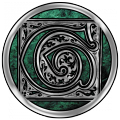 Giovanni
Giovanni
- -- Calogero Giovanni -- The Reluctant Elder Necromancer. Formerly of Quebec City.
The Camarilla Court of Montreal of 2028
Camarilla Archons
- -- Asenneth - Mater Archon (Brujah)
- -- Kisecawchuck -- Cree Gangrel Archon Enforcer
- -- Sévérine Montagne -- French Tremere Archon
- -- LaVey -- Gargoyle Archon Enforcer
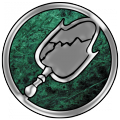 Malkavian
Malkavian
- -- Oscar "The Bloody Butcher" Blackburn -- The notorious 16th century pirate.
- -- Maximilian Graves -- The reputed 17th century British mercenary.
- -- Lord Zarak Fracas -- The famous 18th century duelist.
- -- Abraham Van Hellsing -- A former 19th century vampire hunter.
- -- Ruby Scream -- Presumably the originator of the East Coast "Ruby Scream" urban myth.
 Nosferatu
Nosferatu
- -- Xander
 Toreador
Toreador
- -- François Dumas -- Toreador Prince of Montreal.
 Tremere
Tremere
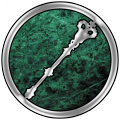 Ventrue
Ventrue
- -- Douglas Callihan -- Ventrue Primogen of Montreal and former anarch leader.
Undercover Agents
The Anarch Movement of 2028
- -- Jerry English
- -- Kelly Huff
- -- Trevor Carlisle
- -- Ivette Vega
- -- Italo Lamon
A List of the Fallen
Stories of Blood and Faith
Websites
http://www.montrealgazette.com/index.html
